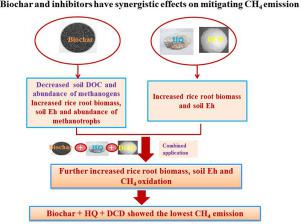Science of the Total Environment ( IF 9.8 ) Pub Date : 2020-07-03 , DOI: 10.1016/j.scitotenv.2020.140500 Tiehu He 1 , Junji Yuan 1 , Jiafa Luo 2 , Stuart Lindsey 2 , Jian Xiang 3 , Yongxin Lin 1 , Deyan Liu 1 , Zengming Chen 1 , Weixin Ding 1

|
Biochar and inhibitors applications have been proposed for mitigating soil greenhouse gas emissions. However, how biochar, inhibitors and the combination of biochar and inhibitors affect CH4 emissions remains unclear in paddy soils. The objective of this study was to explore the effects of biochar application alone, and in combination with urease (hydroquinone) and nitrification inhibitors (dicyandiamide) on CH4 emissions and yield-scaled CH4 emissions during three rice growing seasons in the Taihu Lake region (Suzhou and Jurong), China. In Suzhou, N fertilization rates of 120–280 kg N ha−1 increased CH4 emissions compared to no N fertilization (Control) (P < 0.05), and the highest emission was observed at 240 kg N ha−1, possibly due to the increase in rice-derived organic carbon (C) substrates for methanogens. Biochar amendment combined with N fertilization reduced CH4 emissions by 13.2–27.1% compared with optimal N (ON, Suzhou) and conventional N application (CN-J, Jurong) (P < 0.05). This was related to the reduction in soil dissolved organic C and the increase in soil redox potential. Addition of urease and nitrification inhibitor (ONI) decreased CH4 emissions by 15.7% compared with ON treatment. Combined application of biochar plus urease, nitrification and double inhibitors further decreased CH4 emissions by 22.2–51.0% compared with ON and CN-J treatment. ON resulted in the highest yield-scaled CH4 emissions, while combined application of biochar alone and in combination with the inhibitors decreased yield-scaled CH4 emissions by 12.7–54.9% compared with ON and CN-J treatment (P < 0.05). The lowest yield-scaled CH4 emissions were observed under combined application of 7.5 t ha−1 biochar with both urease and nitrification inhibitors. These findings suggest that combined application of biochar and inhibitors could mitigate total CH4 and yield-scaled CH4 emissions in paddy fields in this region.



























 京公网安备 11010802027423号
京公网安备 11010802027423号